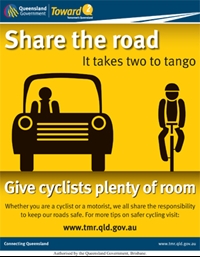Share the road ...
Here in Queensland the State Government, bless 'em, is holding a Parliamentary Inquiry into cycling issues. I made a submission as did many others. There have been some great submissions, and some not so great.
The big mystery is, of course, why the Inquiry is being held in the first place. The plight of cyclists on our roads is clear, and what needs to be done is no mystery. There is a vicious circle affecting cycling in Queensland. Road environment requires cyclists to pretend to be, and compete with cars. As a result most ordinary people, just wanting to get from A to B, don’t want to ride.
These low numbers leads to transport planning, which is done reactively, catering more for cars and making cycling even harder.
Because of all this, cyclists are seen as illegitimate road users and drivers either treat them as a sub-species, or just have no idea how to share the road with them.
Rather than address car addiction, or admit that cars were the problem, mandatory bike helmet laws were introduced. A 'blame the victim' approach to road safety that just made cycling even more unpopular, fuelled the perception that cycling is a dangerous activity, and presented an excuse for Government to avoid spending on proper infrastructure.
Other countries around the world have already come up with the solutions, so why the Inquiry? Why not just get on with fixing it?
what needs to be done is:
1. Proper funding and world best practice design, even if it means taking space away from moving and parked cars. This doesn't mean separated Copenhagen-style paths on every street. It means useful, connected, planned bike routes where necessary, which are separated from cars.
2. Lowering speed limits: 30kph on local streets and 50kph on connector roads. Here in Brisbane, and in most Australian cities, the default speed limit is 50kph. That means that even little laneways, cul-de-sacs, residential neighbourhoods, nursing homes etc. etc. drivers can drive at 50kph and usually drive at 60kph happily. Next up in the hierarchy of roads, collector roads which provide local access but also move traffic from local roads to main routes, speed limits are usually 60kph or 70kph, which means drivers do anywhere between 65 to 80 kph. Seriously, if you drive around Brisbane at or below the speed limit, you will get honked at, abused, or cut off by irate drivers who want to stay with the flow of traffic (generally 5 to 10 kph above the posted limit.
3. Changes to the road rules so that cyclists don't have to pretend to be cars, or are at least protected from cars. Bicycles are not cars and should not be categorised as 'vehicles'. The average person cannot propel a bicycle so as to beat a car to a destination further than 5km away. The average person probably couldn't propel a bicycle across an intersection quicker than a car. Being forced to do so (by having to stop at stop signs or red lights, and being prohibited from crossing with pedestrians) means the average person won't even try.
4. Get rid of mandatory helmet laws. There's lots of evidence that while helmets may prevent some types of head injury in the unlikely event of some types of crashes, the social damage mandatory helmet laws cause (disincentive to cycling, shaping cycling culture as a male-dominated sporting culture, risk compensation, signalling that cyclists are responsible for mitigating danger etc. etc.) far outweighs the advantages. Despite this, State Government still churns out the propaganda.
Some submissions call for an awareness campaign. Even though none have worked before, not even Scotland's depressingly fucked up Niceway Code campaign (which even goes so far to say that cyclists are not even a subspecies, they're horses).
The problem with most government produced awareness campaigns is that they are usually undermined by government's inherent, car-centric bias. Some pinhead in Scotland's traffic department probably thought cyclists wouldn't mind being ridiculed, if it got drivers onside. I wonder how many Scottish cyclists get carrots thrown at them instead of beer bottles.
Australian governments have the same bias. For example, Queensland's 'Share the Road' campaign went to great lengths to deliver twin messages with equal weighting: It takes two to tango, so cyclists follow the road rules and motorists give cyclists plenty of room. Thereby entrenching the fallacy that cyclists disobey the road rules more than cars do.
Here's the message for drivers, encouraging them to give cyclists plenty of room on the road:
It all looks okay doesn't it? No inherent bias here is there? Everyone in their rightful place when sharing the road??
Well, here's how the Dutch give the same message:

